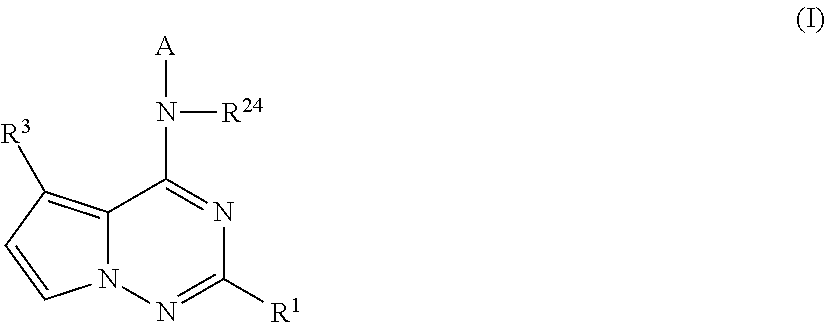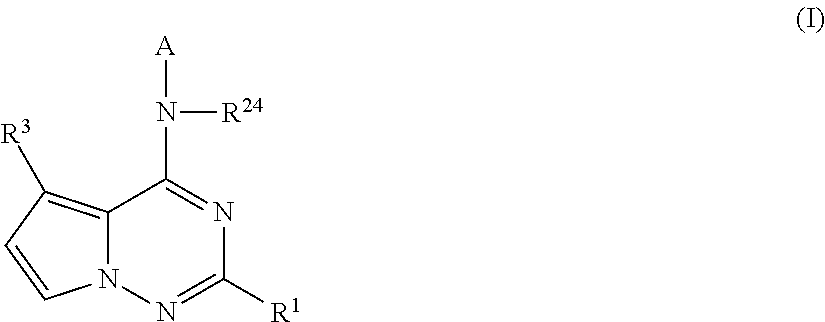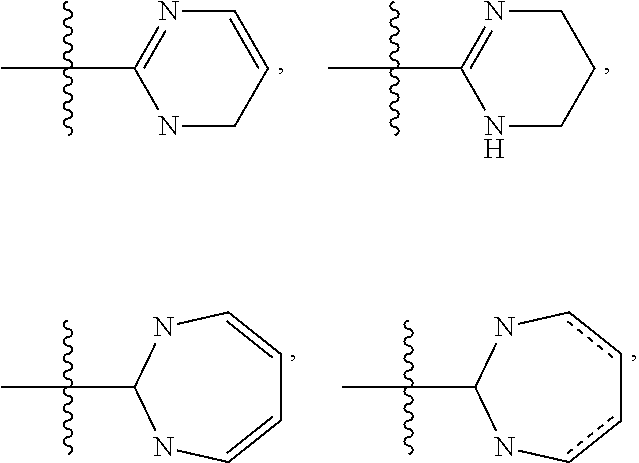Pyrrolotriazines as potassium ion channel inhibitors
a potassium channel and inhibitory technology, applied in the direction of biocide, cardiovascular disorder, drug composition, etc., can solve the problems of neurotoxicity, gastrointestinal discomfort, nephrotoxicity,
- Summary
- Abstract
- Description
- Claims
- Application Information
AI Technical Summary
Benefits of technology
Problems solved by technology
Method used
Image
Examples
example 1
5-(4-(Benzylamino)-5-phenylpyrrolo[1,2-f][1,2,4]triazin-2-yl)pyridine-3-sulfonamide
[0487]
[0488]Synthesis was carried out according to the procedure reported: Hasse et al., Aust. J. Chem., 62(7):683-691 (2009). N-Bromo succinimide was recrystallized from water and (100 g, 564 mmol) was added to a solution of 1-tert-butyl 2-methyl pyrrolidine-1,2-dicarboxylate (34.0 g, 148 mmol) in carbon tetrachloride (17 L). The resulting suspension was heated at 85° C. for 2 h. The reaction mixture was cooled to 0° C. and the precipitated succinimide removed by filtration. The filtrate was concentrated under reduced pressure. The oil obtained was subjected to column chromatography (REDISEP®, silica gel, 120 g, 10% EtOAc / hexanes), gave 1-tert-butyl 2-methyl 3-bromo-1H-pyrrole-1,2-dicarboxylate (18.0 g, 39.1%) as an orange liquid. 1H NMR (400 MHz, CD3OD) δ ppm 1.53 (s, 9H), 3.32 (s, 3H), 6.46 (d, J=3.6 Hz, 1H), 7.44 (d, J=3.6 Hz, 1H).
[0489]To a solution of 1-tert-butyl 2-methyl 3-bromo-1H-pyrrole-1,2...
example 2
5-(5-Phenyl-4-(pyridin-2-ylmethylamino)pyrrolo[1,2-f][1,2,4]triazin-2-yl)pyridine-3-sulfonamide
[0497]
[0498]5-(4-Hydroxy-5-phenylpyrrolo[2,1-f][1,2,4]triazin-2-yl)pyridine-3-sulfonamide (0.150 g, 0.408 mmol) was dissolved in THF (10 mL) and BOP reagent (0.271 g, 0.612 mmol) and DIPEA (0.214 mL, 1.23 mmol) were added. The reaction mixture was stirred at room temperature for 30 min. Pyridin-2-ylmethanamine (0.0660 g, 0.612 mmol) in THF (3 mL) was added to the reaction mixture and the resulting mixture was stirred at room temperature for 14 h. The reaction mixture was concentrated under reduced pressure and water was added to the residue. The aqueous layer was extracted with ethyl acetate (25×2 mL). The organic layer was dried (with anhydrous sodium sulfate), filtered and concentrated under reduced pressure. The residue was purified by CombiFlash (REDISEP®, silica gel, 40 g, 3% methanol in CH2Cl2) to afford 5-(5-phenyl-4-((pyridin-2-ylmethyl)amino)pyrrolo[2,1-f][1,2,4]triazin-2-yl)pyrid...
example 3
N-(5-(5-Phenyl-4-(pyridin-2-ylmethylamino)pyrrolo[1,2-f][1,2,4]triazin-2-yl)pyridin-3-yl)methanesulfonamide
[0499]
[0500]Methyl 1-amino-3-phenyl-1H-pyrrole-2-carboxylate (0.200 g, 0.925 mmol) was dissolved in CH2Cl2 (20 mL) and then was added TEA (0.387 mL, 2.77 mmol), followed by ethylchloroformate (0.0890 mL, 0.925 mmol). The reaction mixture was stirred at room temperature for overnight. Water (50 mL) was added to reaction mixture and the aqueous mixture was extracted with CH2Cl2 (25×2 mL). The organic layer separated and dried over anhydrous sodium sulfate and concentrated under reduced pressure. The residue was purified by silica gel column chromatography using CombiFlash (REDISEP®, silica gel, 24 g, 15% EtOAc / hexanes) to afford methyl 1-((ethoxycarbonyl)amino)-3-phenyl-1H-pyrrole-2-carboxylate (0.100 g, 37.5%). LCMS Condition B-39: retention time 2.14 min, [M+1]=289.0.
[0501]Methyl 1-((ethoxycarbonyl)amino)-3-phenyl-1H-pyrrole-2-carboxylate (1.00 g, 3.47 mmol) was taken in a pres...
PUM
| Property | Measurement | Unit |
|---|---|---|
| Composition | aaaaa | aaaaa |
| Heart rate | aaaaa | aaaaa |
Abstract
Description
Claims
Application Information
 Login to View More
Login to View More - R&D
- Intellectual Property
- Life Sciences
- Materials
- Tech Scout
- Unparalleled Data Quality
- Higher Quality Content
- 60% Fewer Hallucinations
Browse by: Latest US Patents, China's latest patents, Technical Efficacy Thesaurus, Application Domain, Technology Topic, Popular Technical Reports.
© 2025 PatSnap. All rights reserved.Legal|Privacy policy|Modern Slavery Act Transparency Statement|Sitemap|About US| Contact US: help@patsnap.com



